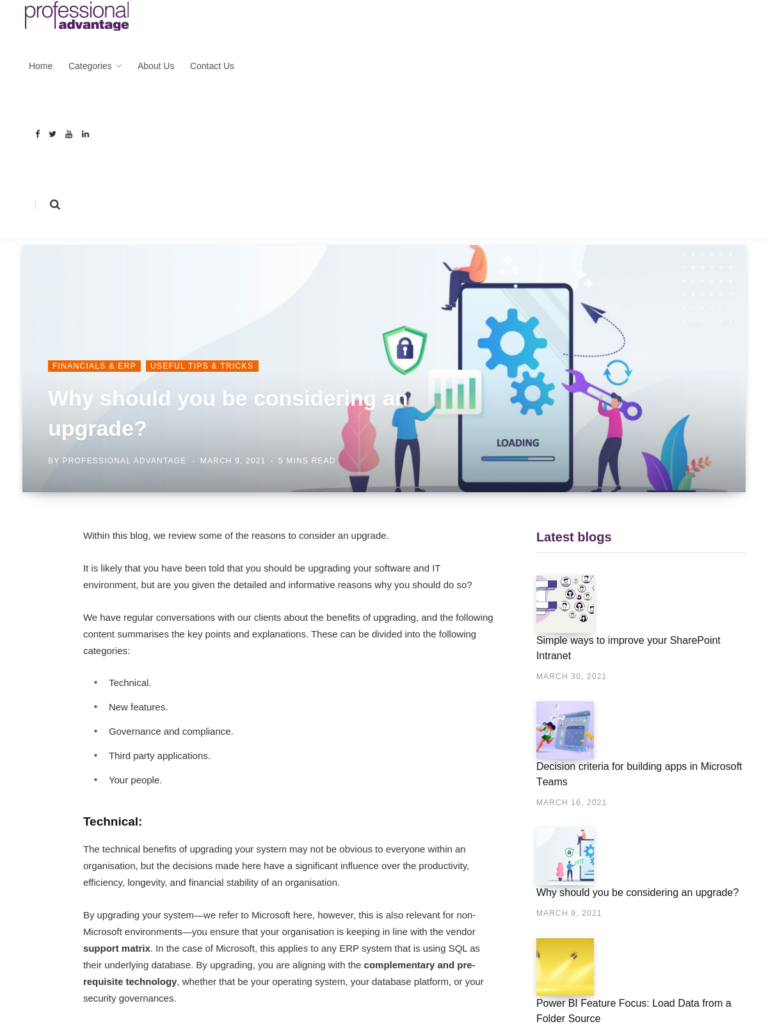Why should you be considering an upgrade?
Blog: Professional advantage - BPM blog
Within this blog, we review some of the reasons to consider an upgrade.
It is likely that you have been told that you should be upgrading your software and IT environment, but are you given the detailed and informative reasons why you should do so?
We have regular conversations with our clients about the benefits of upgrading, and the following content summarises the key points and explanations. These can be divided into the following categories:
- Technical.
- New features.
- Governance and compliance.
- Third party applications.
- Your people.
Technical:
The technical benefits of upgrading your system may not be obvious to everyone within an organisation, but the decisions made here have a significant influence over the productivity, efficiency, longevity, and financial stability of an organisation.
By upgrading your system—we refer to Microsoft here, however, this is also relevant for non-Microsoft environments—you ensure that your organisation is keeping in line with the vendor support matrix. In the case of Microsoft, this applies to any ERP system that is using SQL as their underlying database. By upgrading, you are aligning with the complementary and pre-requisite technology, whether that be your operating system, your database platform, or your security governances.
A factor to consider is backward compatibility, or the lack thereof in some scenarios. If you are proactive in upgrading your SQL, but your ERP system is an older version without the compatibility to a newer version of SQL, this may require you to consider upgrading or seeking an alternative product set.
By keeping your environment up to the latest revision (or at maximum two revisions prior to that) it would mean that you could consider a cloud-based environment, meaning your IT infrastructure spend is minimised.
Other considerations include your technology platform. Typically, the server platform requires a refresh every 4 to 5 years; as above, the vendor support matrix must be considered including server licenses, security patching, business continuity, and finally, disaster recovery.
For organisations who cannot avail themselves of SaaS, the possibility of using Platform as a Service (PaaS) or Infrastructure as a Service (IaaS) is a serious consideration. Owning your ERP license and outsourcing the infrastructure relieves the financial burden of having to have a Capex budget every 4 to 5 years. Having a managed service allows for IT to concentrate on supporting the organisations business aspirations and let the data centre concentrate on the day to day running of the infrastructure service.
New features:
Upgrading on a regular basis ensures your organisation has access to all the latest features, including—but not limited to—new releases; updates; minor enhancements; security patches; and major releases.
Whilst these are all user and business benefits, they ultimately connect to your return on investment: your organisation has invested in a solution and are paying maintenance, so you need to ensure that you are utilising and appreciating the features and enhancements that are being provided to you.
Governance and compliance:
Many organisations will have regulations regarding their governance and compliance. If we use the banking or superannuation industries as an example, they may be governed by APRA with policies stating that they must be on a mainstream support product. Therefore, if the product that they are transacting on falls out of mainstream support, they are no longer compliant with APRA.
Third party applications:
If your organisation is reliant on third-party applications to conduct your business, you need to consider the implications if those third-party applications upgrade and the impact on your solution if there are any incompatibilities. A key driver to staying on the latest version of your solution is so that if your third-party applications upgrade, you can continue to work with them and take full advantage of the service they are providing.
Your people:
Fact: most people want to be using the latest and greatest technology and software. Therefore, by holding back on upgrading, you could be putting a limit on your resource pool: new employees may not want to come and work for an organisation that has a working practice embedded within old technology, and current employees may want to move to organisations that are keeping up with technological movements.
You also risk the longevity of your working practices when employees that know and manage the older technology move on, leaving your organisation without a subject matter expert for your aging and outdated system.
The culture of not updating technology within an organisation and staying current is one that can have a significant negative impact upon your workforce.
Why are you not upgrading?
In our conversations with clients, we have discussed many reasons as to why they might be choosing not to upgrade.
- They do not fully understand the benefits of upgrading, and do not realise what they are missing out on.
- They are worried that there may be disruption to the business.
- It is not their decision to make and are therefore content with using what is provided. They are not empowered, engaged, or involved enough to be able to make the decision, or perhaps do not know enough to be able to present a business case.
- They believe that ‘if it isn’t broken, then don’t fix it’, simply because they do not know how much better it would be if they upgraded.
Do any of these sound familiar?
They do not need to be a reason not to upgrade.
Talk to us today so we can work through your concerns and come up with a solution!
Ultimately upgrading, or at least seriously considering upgrading your solution, is something that should be a high priority for you and your organisation.
The post Why should you be considering an upgrade? appeared first on Enterprise Software Blog – Professional Advantage.
Leave a Comment
You must be logged in to post a comment.








